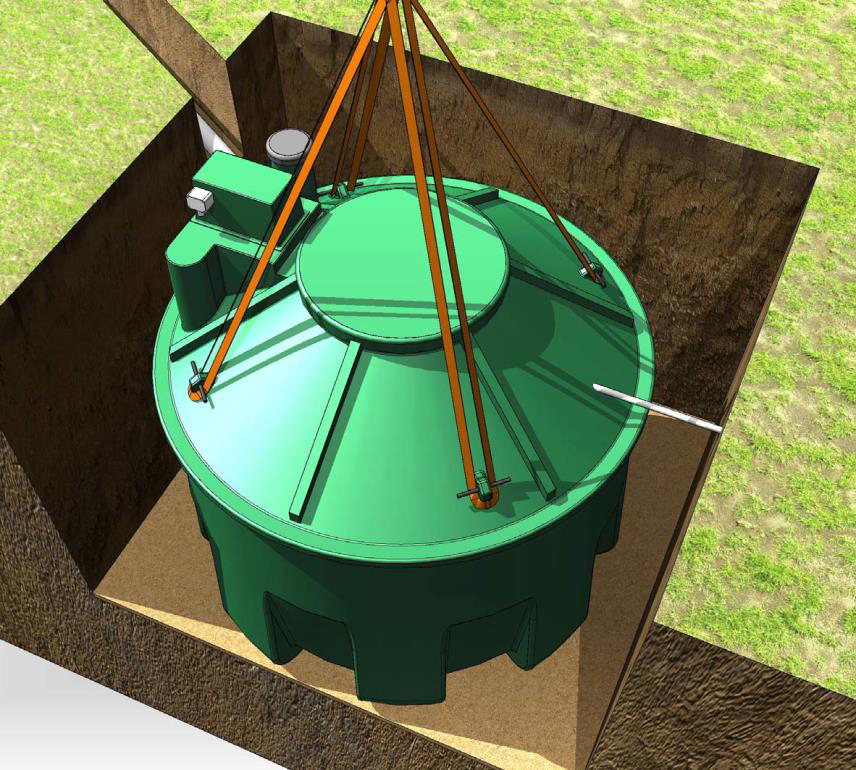When it comes to managing household waste, having a septic tank is a practical and effective solution for many homeowners, especially those not connected to a municipal sewer system. However, selecting the correct size for your septic tank is crucial for ensuring its efficient operation and longevity. In this blog, we’ll explore how to determine the right size septic tank for your home, the benefits of having the appropriate tank size, and the potential consequences of getting it wrong.
Understanding Septic Tank Basics
Before diving into the specifics of sizing, let’s cover some basics about septic tanks. A septic tank is an underground chamber designed to treat and manage wastewater from your home. It works by separating solids from liquids, allowing the solids to settle at the bottom (forming sludge) and the lighter materials, like grease, to float to the top (forming scum). The liquid effluent then exits the tank and is distributed into a drain field or leach field where it further filters through the soil.
Why Tank Size Matters
Choosing the right size septic tank is essential for several reasons:
Capacity to Handle Waste: The tank must be large enough to handle the volume of wastewater generated by your household. An undersized tank may become overloaded, leading to frequent pumping and potential system failure.

Efficient Treatment: A properly sized tank ensures that there is enough time for the wastewater to be adequately treated before it exits the tank. This helps in reducing the risk of contaminants entering the drain field.
Cost Savings: Proper sizing can minimize the frequency of pump-outs and reduce the likelihood of costly repairs or replacements due to overloading.
Environmental Impact: An appropriately sized tank contributes to better wastewater management, which helps in protecting local groundwater and reducing pollution.
Factors to Consider When Choosing Tank Size
Determining the right size for your septic tank involves considering various factors:
Household Size: The number of people living in your home directly impacts the amount of wastewater generated. Larger households produce more waste, which requires a larger tank to accommodate.
Daily Water Usage: Beyond the number of residents, the amount of water used daily plays a crucial role. High water usage, such as frequent laundry or long showers, will necessitate a larger tank.
Type of Wastewater System: Different types of systems, such as gravity-fed or pressure distribution systems, may have specific requirements regarding tank size.
Local Regulations: Local building codes and regulations often dictate the minimum size requirements for septic tanks. It’s important to adhere to these guidelines to ensure compliance.
Soil and Site Conditions: The characteristics of your soil and the layout of your site can affect the size of the septic system needed. Certain soil types may require a larger tank to manage effluent effectively.
Calculating the Right Size
To accurately determine the appropriate septic tank size for your home, follow these steps:
Estimate Daily Wastewater Volume: A general rule of thumb is that a household of four typically generates around 1,000 to 1,200 gallons of wastewater per day. This estimate helps in gauging the minimum tank capacity needed.
Determine Tank Capacity: Septic tanks are commonly sized in terms of gallons. For a typical household, a tank with a capacity of at least 1,000 gallons is often recommended. Larger homes or those with higher water usage may require tanks ranging from 1,500 to 2,000 gallons or more.
Consult with Professionals: Engage with a septic system professional or engineer to assess your specific needs. They can provide a more accurate calculation based on your household’s water usage, soil conditions, and other relevant factors.
Benefits of the Right Tank Size
Having the correct size septic tank brings several advantages:
Efficient Waste Management: A properly sized tank ensures efficient separation of solids and liquids, which enhances the treatment process and prevents overloading of the system.
Reduced Maintenance Costs: Correct sizing can lead to fewer pump-outs and lower maintenance costs. An undersized tank may require more frequent pumping and incur higher costs over time.
Longer System Life: A tank that is too small for your needs will experience excessive strain, potentially leading to premature system failure. A correctly sized tank contributes to the longevity and reliability of your septic system.
Environmental Protection: Properly sized septic tanks reduce the risk of overflow and contamination of the surrounding environment. This helps in maintaining groundwater quality and preventing pollution.
Compliance with Regulations: Adhering to local regulations regarding septic tank sizing helps in avoiding legal issues and ensures that your system operates within the prescribed guidelines.
Consequences of Incorrect Tank Sizing
While it’s clear that the right tank size is beneficial, getting it wrong can lead to several issues:
Overloading: An undersized tank may become overloaded quickly, leading to inefficient treatment and potential backup problems. This can cause unpleasant odors, slow drainage, and system malfunctions.
Frequent Pumping: Smaller tanks will require more frequent pumping to prevent overflow and maintain functionality. This not only increases maintenance costs but also disrupts your daily life.
Soil Saturation: Excessive wastewater from an overloaded tank can saturate the surrounding soil, impairing the effectiveness of the drain field and potentially causing system failure.
Health Hazards: Inefficient treatment due to a small tank can lead to the discharge of untreated or partially treated wastewater into the environment, posing health risks to you and your community.
Property Damage: Overflows and backups can cause significant damage to your property, including landscaping, driveways, and structures. This can be costly to repair and may impact your property value.
Tips for Proper Maintenance
To ensure the longevity and efficiency of your septic system, consider these maintenance tips:
Regular Pumping: Schedule regular pump-outs based on your tank size and household usage. For most systems, this is typically every 3 to 5 years.
Monitor Water Usage: Be mindful of your household water usage and avoid excessive use, which can strain your septic system.
Avoid Flushing Non-Biodegradable Items: Dispose of items like wipes, fats, oils, and non-biodegradable materials properly to prevent clogging and damage to the system.
Inspect the System: Regularly inspect your septic system and drain field for any signs of trouble, such as standing water or unpleasant odors.
Educate Household Members: Ensure everyone in your household understands the importance of proper septic system use and maintenance.
Selecting the right size septic tank is a critical aspect of managing household wastewater effectively. It ensures efficient waste treatment, reduces maintenance costs, and protects both your property and the environment. By considering factors such as household size, daily water usage, and local regulations, you can make an informed decision and enjoy the benefits of a well-functioning septic system. Regular maintenance and awareness will further enhance the longevity and efficiency of your septic system, ensuring that it continues to serve your home effectively for years to come.
Related Posts
- Design and Sizing Considerations for Home Sewage Treatment Systems
- Where Are Septic Tanks Used
- Understanding Recycled Water Classifications in Australia
- Why We Need Home Sewage Treatment Plant Maintenance
- Off-the-Grid Living: How AWTS Systems Empower Sustainable Lifestyles in Australia
- How does Wastewater and Greywater differ?
- How Does AWTS (Aerated Water Treatment System) Work?
- Cracking the Code: Understanding Water Quality Standards in Australia




